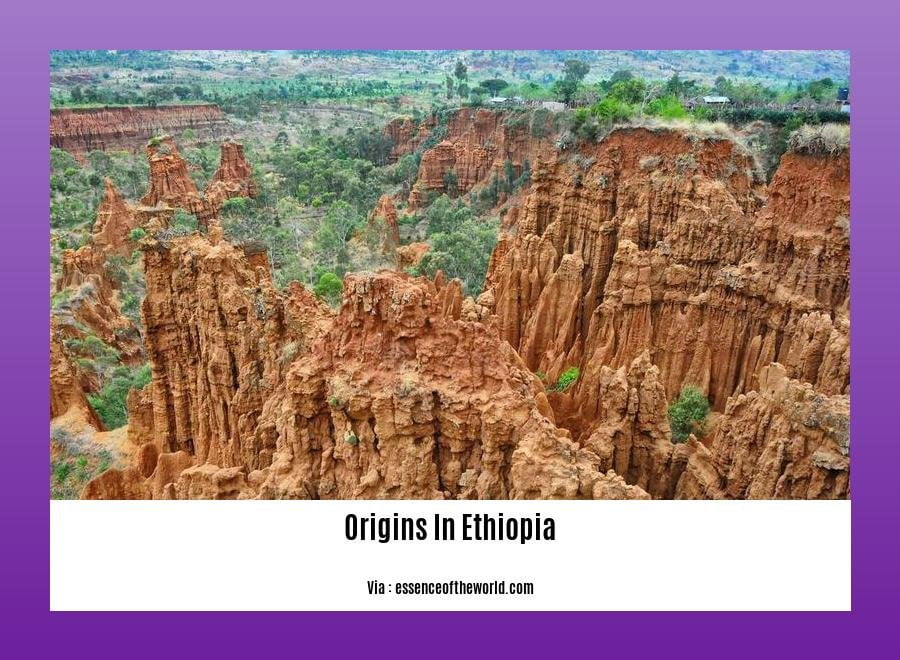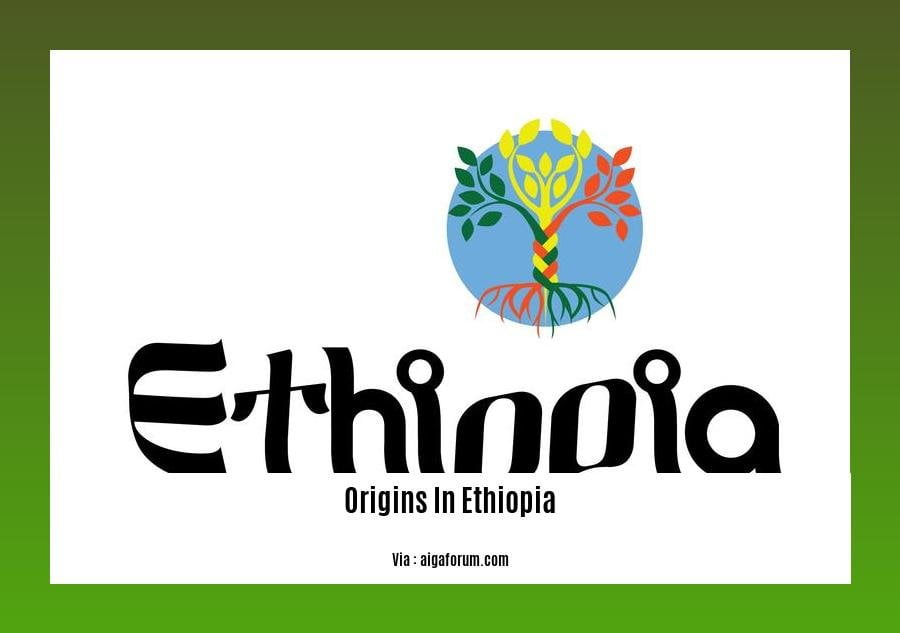Embark on a captivating journey to the very heart of our origins at [-The Cradle of Humanity: Origins in Ethiopia]. Join us as we delve into the enigmatic landscapes of Ethiopia, where groundbreaking discoveries have unveiled the remarkable tapestry of our evolutionary odyssey. From the ancient hominid remains of the Great Rift Valley to the rich archaeological sites that illuminate our ancestors’ lives, we’ll explore the fascinating origins of humanity in the Horn of Africa.
Key Takeaways:
- “Ethiopia” means “burnt face” in Greek.
- Ancient Egypt called Ethiopia “Punt” and “Yam” in 3000 BC.
- Cushitic language speakers are believed to be the first inhabitants of Ethiopia.
- The Ethiopian Kingdom was founded in the 10th century B.C. by Menelik I, Solomon’s son.
- Ethiopia is the only African nation never formally colonized.
Origins in Ethiopia

Ethiopia, a land of historical and cultural significance, has played a pivotal role in the story of human evolution.
The Earliest Footprints
The discovery of Lucy, a 3.2-million-year-old hominid, at Hadar in the Afar region, has been a groundbreaking moment in our understanding of human origins. Lucy, classified as Australopithecus afarensis, has provided insights into our early ancestors’ physical characteristics and behavior.
The Evolutionary Journey
Over time, human evolution continued in this region, with the emergence of Homo erectus and Homo sapiens in the Ethiopian highlands. These species embarked on migrations out of Africa, spreading our lineage across the globe.
Archaeological Treasures
Ethiopia is a treasure trove of archaeological sites that reveal our evolutionary journey. The Gona site has yielded hominid fossils dating back 2.5 million years, while the Omo Kibish Formation contains the remains of Homo sapiens idaltu, dating back 160,000 years.
The Cradle of Humanity
With its rich fossil record, genetic diversity, and diverse landscapes, Ethiopia stands as a testament to our shared origins. It is the place where the tapestry of human history began to be woven, shaping the destiny of our species.
Table: Key Archaeological Sites in Ethiopia
| Site | Region | Age (years) | Significance |
|---|---|---|---|
| Hadar | Afar | 3.2 million | Lucy’s discovery |
| Gona | Afar | 2.5 million | Early hominid fossils |
| Omo Kibish | Omo Valley | 160,000 | Remains of Homo sapiens idaltu |
| Ledi-Geraru | Afar | 2.8 million | Stone tool evidence |
| Daka | Nile Valley | 1.2 million | Homo erectus remains |
Did you know about the rich history behind your favorite beverage? Visit our page on the History of Coffee, where you’ll discover the fascinating origins of this beloved drink.
Delve into the captivating tale of how coffee culture spread across the globe. Our article on the Spread of Coffee Culture explores the intriguing journey of this beverage from its humble beginnings to its widespread popularity.
Explore the remarkable impact coffee has had on the global economy through our insightful page on Impact on Global Economy. Uncover the fascinating role coffee has played in shaping international trade and economies around the world.
Lucy: The Celebrated Australopithecus Fossil

In the chronicles of human history, few discoveries rival the significance of Lucy: The Celebrated Australopithecus Fossil. Unearthed in Ethiopia’s Hadar region in 1974, Lucy has revolutionized our understanding of our origins.
Who was Lucy?
Lucy was a 3.2-million-year-old female hominin belonging to the species Australopithecus afarensis. Her fossilized skeleton, remarkably complete, provided a priceless glimpse into the transitional stage between apes and humans.
Key Features of Lucy
- Small Skull: Lucy’s skull was ape-like in size, indicating small brain volume.
- Bipedal Gait: Her leg bones and pelvis suggest she walked upright like humans.
- Mosaic of Traits: Lucy exhibited a combination of ape-like and human-like features, underscoring the gradual evolution of our species.
Lucy’s Impact on Human Evolution
Lucy’s discovery has fundamentally altered our understanding of human evolution. Her bipedalism suggests that walking upright preceded the increase in brain size, challenging previous theories. Moreover, Lucy’s existence in Ethiopia reinforces the notion of Africa as the cradle of humanity.
Key Takeaways:
- Lucy is a fossilized skeleton of an early hominin, Australopithecus afarensis.
- Discovered in Ethiopia in 1974, Lucy is approximately 3.2 million years old.
- Her fossilized remains exhibit both ape-like and human-like features.
- Lucy’s bipedalism suggests that walking upright preceded brain size increase in human evolution.
- Lucy’s discovery supports the theory of Africa as the cradle of humanity.
Sources:
Lucy (Australopithecus) – Wikipedia
Lucy – Human Origins Program
Human Evolutionary Adaptations in the East African Rift System
Key Points:
- East Africa served as a crucial backdrop for major hominin evolutionary events.
- A dynamic environment molded by volcanic activity and climate changes fostered unique evolutionary adaptations in our ancestors.
- The East African Rift’s sedimentary deposits offer invaluable insights into hominin fossil sites and their surrounding paleoenvironments.
Ecological Challenges and Evolutionary Responses
The East African Rift System provided a challenging and ever-changing environment for early hominins, shaping their development and survival strategies. Volcanic eruptions and tectonic shifts created dramatic changes in landscapes and resources, while orbital fluctuations influenced climate patterns. These environmental shifts drove Human Evolutionary Adaptations in the East African Rift System:
- Bipedalism: Walking upright freed hands for tool use and carrying resources, enhancing survival in open habitats.
- Hunting and Meat Consumption: Shifting ecosystems and the emergence of savannas promoted hunting and scavenging, augmenting dietary options.
- Social Cooperation and Tool Development: The harsh environment encouraged social bonds and the utilization of tools to access food and shelter.
- Cognitive Development: Environmental pressures fostered cognitive adaptations, including problem-solving and communication.
Key Takeaways:
- The East African Rift System played a pivotal role in shaping human evolution.
- Environmental challenges promoted adaptations in bipedalism, social behavior, and cognition.
- Fossil and archaeological evidence from this region provides a rich understanding of hominin evolution.
Relevant Sources:
- Human Evolution in a Variable Environment: The Amplifier Lakes of the Turkana Basin
- East African Climate Pulses and Early Human Evolution
The Genetic Legacy of Homo sapiens in Ethiopia
The East African Rift Valley serves as a significant site for researching human evolution, with Ethiopia at the heart of these inquiries. The country’s abundant fossil record, diverse ethnic groups, and historical significance showcase the genetic legacy of our species.
Genetic Divergence and Archaeological Discoveries
Genetic research suggests that the Genetic Legacy of Homo sapiens in Ethiopia diverged from other hominids approximately 300,000 years ago. Excavations in the Omo Kibish Formation have unearthed fossils of Homo sapiens idaltu dating back 160,000 years. These discoveries support the hypothesis that Ethiopia was a crucial region for the emergence of modern humans.
Complex Ancestral History
Genetic studies have revealed a complex ancestral history for Ethiopian populations. Different ethnic groups exhibit unique genetic profiles, reflecting both ancient migrations and local adaptations. The Afar people, for instance, carry ancient genetic lineages not found in other African populations.
Cradle of Diversity
Ethiopia’s genetic diversity stems from various factors. Its varied landscapes, including mountains, grasslands, and deserts, provided distinct habitats for human populations. Additionally, the country served as a crossroads for migrations, allowing for genetic exchange between different groups.
Key Takeaways:
- Genetic research indicates Genetic Legacy of Homo sapiens in Ethiopia dates back 300,000 years.
- Archaeological discoveries, such as the Omo Kibish Formation, provide evidence of Homo sapiens existence in Ethiopia over 160,000 years ago.
- Genetic studies reveal complex ancestral histories and genetic diversity among Ethiopian ethnic groups.
- Ethiopia’s geographic diversity and the crossroads of migrations have contributed to its rich genetic heritage.
Relevant Sources:
- Ha’aretz: New Genetic Findings Suggest Humans Emerged in Africa 300,000 Years Ago
- Smithsonian Magazine: The Oldest Homo sapiens Fossils Outside of Africa
FAQ
Q1: What evidence supports the theory of human origins in Ethiopia?
A1: Ethiopia has yielded significant fossil discoveries, including Lucy, the oldest known hominin fossil, and the Omo I bones, suggesting human presence at least 230,000 years ago.
Q2: How did the environment in East Africa contribute to human evolution?
A2: East Africa’s environmental instability due to volcanic activity and orbital changes provided diverse habitats that fostered hominin adaptation and speciation.
Q3: What is the significance of genetic studies in understanding Ethiopian origins?
A3: Genetic research reveals the complex ancestral history and genetic diversity among Ethiopian ethnic groups, providing insights into human migration and interbreeding.
Q4: How has Ethiopia’s unique history influenced its culture and heritage?
A4: As the only African nation never formally colonized, Ethiopia has preserved its rich cultural traditions, including its ancient Orthodox Christian churches and its diverse ethnic communities.
Q5: What current research is being conducted in Ethiopia to further explore human origins?
A5: Ongoing excavations and genetic studies in Ethiopia aim to uncover new fossil evidence, analyze hominin behavior, and trace the genetic roots of modern human populations.












